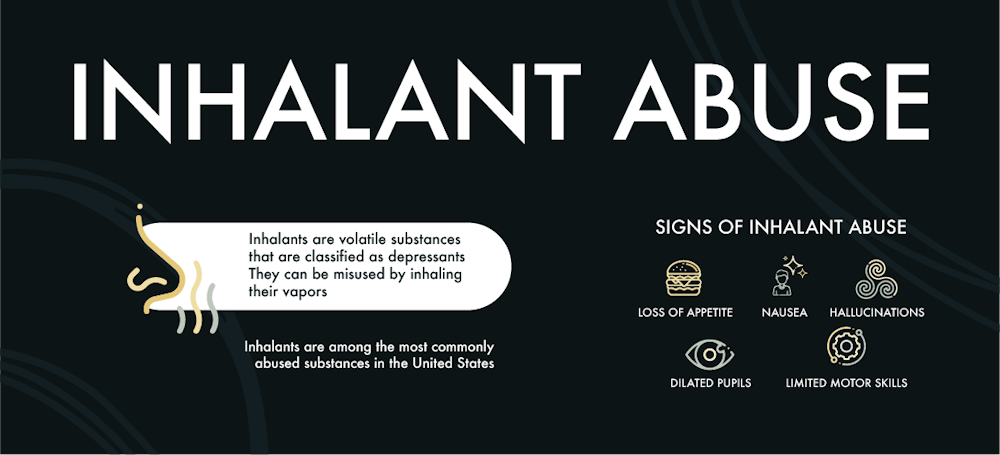Inhalant Abuse Treatment in Texas
Chronic use of inhalants to produce feelings of intoxication can cause serious damage to your mind and body. Abusing inhalants can lead to long-term addiction and dependency. The majority of those who abuse inhalants are adolescents between the ages of 13 and 17. Just like any other form of substance use, adolescent addiction treatment is available for you and your family.
Be aware of the signs and symptoms of inhalant abuse to keep your loved ones safe. Make sure to seek professional treatment if you or a loved one may be struggling with inhalant abuse.
What are Inhalants?
Inhalants include a wide range of chemicals found in industrial or household products that cause intoxication. Inhaling these chemicals has an immediate, mind-altering effect on the brain. Chronic inhalant abuse can lead to serious health problems and even death.
Who Abuses Inhalants?
 Inhalant abuse is typically seen in adolescents around the age of 14 to 15, but there have been reports of abuse in children as young as 5. Rates of abuse begin to decline between the ages of 17 and 19. Studies have also concluded that males are more likely to abuse inhalants than females.
Inhalant abuse is typically seen in adolescents around the age of 14 to 15, but there have been reports of abuse in children as young as 5. Rates of abuse begin to decline between the ages of 17 and 19. Studies have also concluded that males are more likely to abuse inhalants than females.
Anyone can become a victim of inhalant abuse but certain groups of people are more prone to it. People have a higher chance of abusing inhalants if they:
- Come from low-income homes
- Have a history of mental health disorder
- Suffer from violence or sexual abuse
- Have a criminal record
- Abuse drugs
In many cases, clients turn to substance abuse as a coping mechanism. Consuming inhalants creates a short high that will provide temporary relief. However, people become addicted to this feeling and need to consume more inhalants to get the same effect.
It is important to have healthy coping mechanisms when going through hardship. If you or a loved one are struggling to resist addictive urges, look into alcohol rehab in Houston, Texas.
Types of Inhalants Abused
There are over 1,000 items found at home or in the workplace that can be classified as an inhalant. These products are cheap and legal, which makes them easily accessible. Inhalants can be classified into four categories, including volatile solvents, aerosols, gases, and nitrites.
Volatile solvents are a type of liquid that transforms into a gas at room temperature. Examples of volatile solvents include
- Gasoline
- Lighter fluid
- Paint thinners
- Glues
- Nail polish removers
- Felt tip markers
Aerosols are sprays that contain intoxicant chemicals. They can be found in products such as
- Hair spray
- Vegetable oil spray
- Spray paint
- Spray deodorant
Gases can include anesthetics used for medical purposes along with gases contained in household or industrial products. Types of gases that are abused include
- Nitrous oxide
- Chloroform
- Halothane
- Butane lighters
- Propane tanks
Nitrous oxide is the most abused gas and can be found in containers used for whipped cream. These are commonly known as “whippets.”
Nitrites are chemicals that produce an aroma that directly affects the central nervous system. They can act as muscle relaxers and cause blood vessels to dilate. Nitrites can be found in products such as
- Leather cleaners
- Room deodorizers
- Liquid aroma
Many of these items can be found in any household or workplace, and you may not have known that they could be used as an inhalant. It is important to keep these items out of the reach of children and stored in a safe location.
Signs and Symptoms of Inhalant Abuse

Inhalant abuse may not be apparent right away, so it is important to watch out for the signs and symptoms. One of the first signs of inhalant abuse is that a person may have traces of chemicals on their clothing or skin. For example, someone who is sniffing aerosols may smell like paint or an air freshener.
Those who are abusing inhalants will most likely exhibit patterns or behaviors that are unusual. Pay attention to certain behaviors that may be irregular or sporadic such as
- Changes in appetite
- Chemical odors on the breath, skin, or clothing
- Paint stains
- Weight loss
- Experiencing anxiety
- Depression
- A decline in school performance
- Nosebleeds
- Irritation around the nose or mouth
The signs and symptoms of inhalant abuse may be hard to identify, so it is important to communicate with a loved one who may be struggling with this condition. Confronting a loved one about their behavior can be difficult, but it will only benefit them. Although they may become upset or angry with you, it is important to remember you are doing what is right for them.
How are Inhalants Abused?
 Inhalants are consumed through the mouth and nose using various methods. Some of the most common ways people consume inhalants include sniffing chemical fumes from a container or spraying them directly into their mouth or nose. Pieces of fabric such as towels or clothes may be soaked in a chemical and placed over the mouth and nose to produce a quick high. Containers may also be filled with inhalants that can be consumed over time.
Inhalants are consumed through the mouth and nose using various methods. Some of the most common ways people consume inhalants include sniffing chemical fumes from a container or spraying them directly into their mouth or nose. Pieces of fabric such as towels or clothes may be soaked in a chemical and placed over the mouth and nose to produce a quick high. Containers may also be filled with inhalants that can be consumed over time.
Inhalants typically have an effect that lasts only a few minutes, so people will consume them regularly to get the same effect. After using inhalants for an extended period, people will become reliant on them to feel normal. This leads to addiction and can have serious physical and psychological effects.
What are the Side Effects of Chemical Inhalants?
Inhalant abuse can cause serious mental and physical damage because it directly impacts the central nervous system. The central nervous system acts as the control center for the human body. Anything that affects the central nervous system will affect all systems in the brain and body.
Inhalant abuse is especially dangerous because of how fast the chemicals absorb into the brain. Side effects of inhalant abuse can be classified into short and long-term effects.
The short-term effects of inhalant abuse are similar to those of drinking alcohol. They include
- Elevated mood
- Dizziness
- Headaches
- Tiredness
- Blurred vision
- Upset stomach
- Confusion
- Loss of coordination
Although these symptoms are relatively minor, chronic use of inhalants can lead to addiction. The side effects of long-term inhalant abuse include
- Lung damage
- Seizures
- Kidney failure
- Brain damage
- Irregular heartbeat
- Coma
- Death
Minor symptoms of inhalant abuse may not lead to prolonged health effects, but that does not mean it is safe to use in small doses. It is impossible to predict how your body may react to a certain chemical because it affects everyone differently.
How Do Inhalants Damage the Brain and Body?
Inhalants rapidly absorb into the brain and produce an immediate high. However, this high only lasts for a few minutes. Prolonged use of inhalants can cause irreversible damage to the brain and body. Inhalants can reduce the amount of oxygen in the brain leading to brain damage. Depending on the severity of the brain damage, people may suffer from
- Memory loss
- Learning disabilities
- Difficulty speaking
- Loss of coordination
- Impaired vision
Can a Person Overdose on Inhalants?
Yes, you can overdose on inhalants. Products that contain high concentrations of chemicals can have life-threatening effects. Inhaling these chemicals can cause a person to have a seizure or go into cardiac arrest even if it is the first time. If a person fills their lungs with toxic chemicals in place of oxygen, they can die from asphyxiation. Covering your head with a bag to inhale chemicals can also cause a person to suffocate and die.
It is not worth it to abuse inhalants. Just one dosage could be fatal. If you are at risk of abusing inhalants, don’t hesitate to contact a medical professional and learn about treatment program options.
How is Inhalant Abuse Diagnosed?
Clinical diagnosis by a medical professional is required to diagnose inhalant abuse. Inhalants will not show up on a typical drug test, so clinicians use other forms of laboratory testing. This may include doing blood and tissue testing to determine what chemicals are in your body.
Can Inhalant Abuse Be Prevented?
People who have had life skills training in school are far less likely to abuse inhalants. Life skills training improves self-confidence, social interaction, and anxiety management. Developing these skills at an early age help adolescents cope with problems in their everyday life without turning to substance use.
Treatment for Inhalant Abuse

Treatment for inhalant abuse is similar to conventional addiction treatment methods. Clients will engage in certain forms of therapy such as cognitive behavioral therapy (CBT), dialectical behavioral therapy (DBT), group therapy, or family therapy. Additionally, clients will partake in aftercare programs for relapse prevention purposes.
The goal of inhalant abuse treatment is to provide clients with the skills necessary to overcome addiction. Treatment programs offer a variety of solutions that help a client through the recovery process.
Inhalant Addiction Treatment is Available at Luna Recovery
Located in Houston, TX, Luna Recovery is committed to helping clients achieve recovery. We offer a wide variety of treatment programs tailored to clients’ needs. Our highly trained staff is trained to provide the top-of-the-line care that our clients deserve. No matter where you are from, we have a program that is right for you.
If you or a loved one may be suffering from inhalant abuse, it is crucial to seek immediate help from a professional. Contact us today to learn more about our treatment facility in Houston, TX!
Dr. Allaire received his Bachelors of Science in Biology from the University of Houston, as Valedictorian of the College of Natural Sciences and Mathematics, and his Medical Doctorate from Baylor College of Medicine, where he served as Chief Resident. He is the medical monitor for the Physician Counseling Committee of the Harris County Medical Society and the Medical Director of Serenity House Detox. Dr. Allaire specializes in medically assisted detox cases, treating patients in recovery from addiction or other mental health disorders, the medical assessment and monitoring of patients with addictive disorders, medical care related to eating disorders and the medical treatment of patients with mental health conditions.



